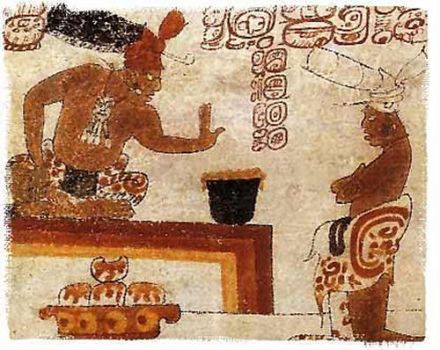 |
All About Chocolate > Cocoa in Mexico
When the first Spanish conquerors arrived in Mexico, they discovered a highly advanced, yet strange, civilization. A renowned gourmand, Montezuma would have dozens of dishes served to him in his palace, and the meal would end with a frothy chocolate beverage that serving girls brought in bowls and that he would drink from a golden cup. The chocolate they brought the sovereign rounded out the meal: green chocolate made with young cocoa, chocolate with honey flavoured with dried ground flowers and green vanilla beans, orange-coloured chocolate, dark chocolate, white chocolate…
In Mexico, the aristocracy began to consume more and more hot chocolate. Women commonly had a finely carved goblet of it served to them every two hours and even long religious services did not interfere with this ritual. The bishop of Chiapas castigated the faithful, imploring them to use temperance during services, but these ladies would do only as they wished. In an ironic twist, the bishop died of poisoning… from a cup of chocolate.
To better conform to Spanish tastes, the nuns of Oaxaca added vanilla, orange flower water and musk to chocolate and sweetened it with agave sugar.
The Aztec emperors' hot chocolate descended to the people in the street and in the 16th century, you could go to a chocolateria to have a hot chocolate, thickened with corn flour and flavoured with cinnamon, cloves and vanilla. Even today, chocolate is drunk here in the morning while half of the planet is having their coffee.
During the reign of the Hapsburg emperor Maximilian, Mexican cuisine became more refined as Maximilian and his empress Charlotte became increasingly bewitched by Mexico. Charlotte was won over by chocolate and quickly exchanged her tea for this divine beverage. She even began special tasting evenings at which she served candies, brioches and other delicacies.
Though Mexicans associate chocolate with a hot drink, they caused a great culinary stir when they invented a cocoa and chili-based sauce to enliven chicken and turkey, a classic that the adventurous can try for themselves. It seems to date from the Aztec period and it traditionally took three days to make this thick, brown and distinctively-flavoured sauce. All the ingredients were crushed in a "molcajete," a mortar set on a tripod made from volcanic stone.
But the modern version can be traced back to the 16th century and the convent of Santa Rosa in Puebla, a state in south-central Mexico, west of Veracruz. The nuns, renowned for their culinary skills, found out on the very day of his arrival that the archbishop of the diocese had decided to pay them a visit… and to stay for dinner. In a panic, and after a short prayer asking heaven for some inspiration on how to satisfy such a distinguished guest, they brought out everything they could find in the pantry. In a large bowl they mixed together the traditional chili peppers, then added almonds, tomatoes, garlic, onions, bread, tortillas, sesame seeds, sugar, raisins, bananas, lard, avocado leaves, herbs and a few other spices. They pounded and blended the mixture and added a little bitter chocolate to heighten the flavour. While this "mole," or sauce was simmering, they sacrificed a turkey and simply put it on to roast. And so they were able to set before the prelate a turkey covered with this miraculous sauce. He was enchanted.


-

 Recipes
Recipes
-

 Products
Products
-

 Entertaining
Entertaining
-

 Chefs
Chefs
-

 Hints & Tips
Hints & Tips
-

 Glossaries
Glossaries








